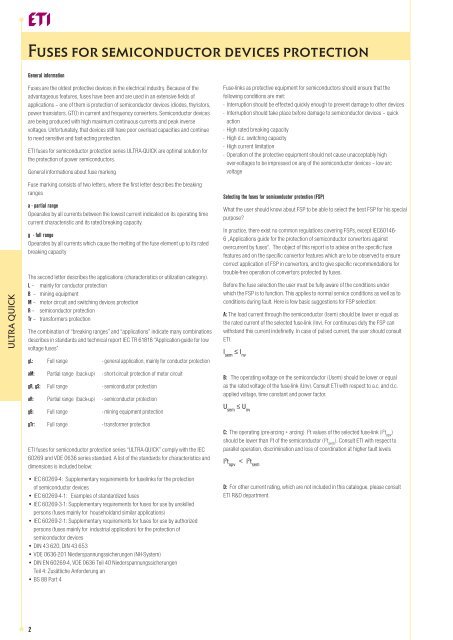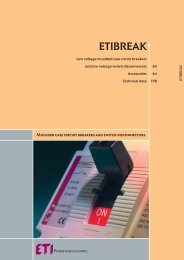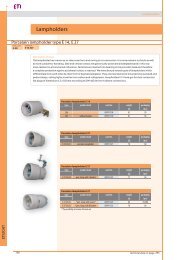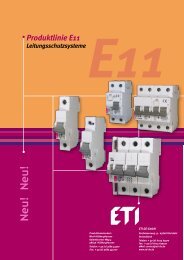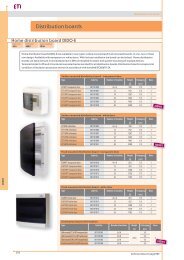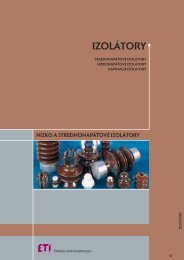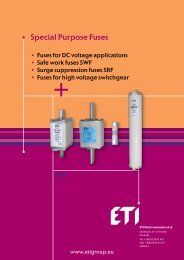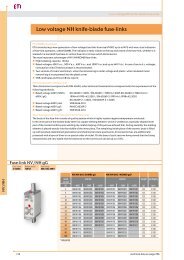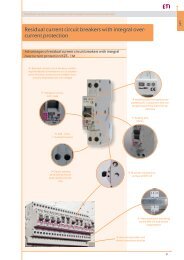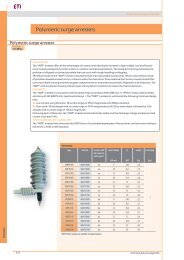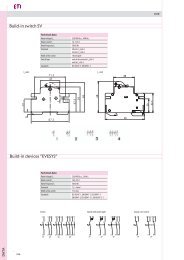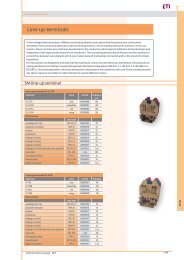NV/NH - Eti-de.de
NV/NH - Eti-de.de
NV/NH - Eti-de.de
You also want an ePaper? Increase the reach of your titles
YUMPU automatically turns print PDFs into web optimized ePapers that Google loves.
Fuses for semiconductor <strong>de</strong>vices protectionGeneral informationULTRA QUICKFuses are the ol<strong>de</strong>st protective <strong>de</strong>vices in the electrical industry. Because of theadvantageous features, fuses have been and are used in an extensive fields ofapplications – one of them is protection of semiconductor <strong>de</strong>vices (dio<strong>de</strong>s, thyristors,power transistors, GTO) in current and frequency converters. Semiconductor <strong>de</strong>vicesare being produced with high maximum continuous currents and peak inversevoltages. Unfortunately, that <strong>de</strong>vices still have poor overload capacities and continueto need sensitive and fast-acting protection.ETI fuses for semiconductor protection series ULTRA-QUICK are optimal solution forthe protection of power semiconductors.General informations about fuse markingFuse marking consists of two letters, where the first letter <strong>de</strong>scribes the breakingrangesa - partial rangeOpearates by all currents between the lowest current indicated on its operating timecurrent characteristic and its rated breaking capacity.g - full rangeOpearates by all currents which cause the melting of the fuse element up to its ratedbreaking capacityThe second letter <strong>de</strong>scribes the applications (characteristics or utilization category).L – mainly for conductor protectionB – mining equipmentM – motor circuit and switching <strong>de</strong>vices protectionR – semiconductor protectionTr – transformers protectionThe combination of “breaking ranges” and “applications” indicate many combinations<strong>de</strong>scribes in standards and technical report IEC TR 61818 “Application-gui<strong>de</strong> for lowvoltage fuses”gL: Full range - general application, mainly for conductor protectionaM: Partial range (back-up) - short-circuit protection of motor circuitgR, gS: Full range - semiconductor protectionaR: Partial range (back-up) - semiconductor protectiongB: Full range - mining equipment protectiongTr: Full range - transformer protectionETI fuses for semiconductor protection series “ULTRA-QUICK” comply with the IEC60269 and VDE 0636 series standard. A list of the standards for characteristics anddimensions is inclu<strong>de</strong>d below:• IEC 60269-4: Supplementary requirements for fuselinks for the protectionof semiconductor <strong>de</strong>vices• IEC 60269-4-1: Examples of standardized fuses• IEC 60269-3-1: Supplementary requirements for fuses for use by unskilledpersons (fuses mainly for householdand similar applications)• IEC 60269-2-1: Supplementary requirements for fuses for use by authorizedpersons (fuses mainly for industrial application) for the protection ofsemiconductor <strong>de</strong>vices• DIN 43 620, DIN 43 653• VDE 0636-201 Nie<strong>de</strong>rspannungssicherungen (<strong>NH</strong>-System)• DIN EN 60269-4, VDE 0636 Teil 40 Nie<strong>de</strong>rspannungssicherungenTeil 4: Zusätliche Anfor<strong>de</strong>rung an• BS 88 Part 4Fuse-links as protective equipment for semiconductors should ensure that thefollowing conditions are met:- Interruption should be effected quickly enough to prevent damage to other <strong>de</strong>vices- Interruption should take place before damage to semiconductor <strong>de</strong>vices – quickaction- High rated breaking capacity- High d.c. switching capacity- High current limitation- Operation of the protective equipment should not cause unacceptably highover-voltages to be impressed on any of the semiconductor <strong>de</strong>vices – low arcvoltageSelecting the fuses for semiconductor protection (FSP)What the user should know about FSP to be able to select the best FSP for his specialpurpose?In practice, there exist no common regulations covering FSPs, except IEC60146-6 „Applications gui<strong>de</strong> for the protection of semiconductor convertors againstovercurrent by fuses”. The object of this report is to advise on the specific fusefeatures and on the specific convertor features which are to be observed to ensurecorrect application of FSP in convertors, and to give specific recommendations fortrouble-free operation of convertors protected by fuses.Before the fuse selection the user must be fully aware of the conditions un<strong>de</strong>rwhich the FSP is to function. This applies to normal service conditions as well as toconditions during fault. Here is few basic suggestions for FSP selection:A: The load current through the semiconductor (Isem) should be lower or equal asthe rated current of the selected fuse-link (Inv). For continuous duty the FSP canwithstand this current in<strong>de</strong>finetly. In case of pulsed current, the user should consultETI.I sem≤ I nvB: The operating voltage on the semiconductor (Usem) should be lower or equalas the rated voltage of the fuse-link (Unv). Consult ETI with respect to a.c. and d.c.applied voltage, time constant and power factor.U sem≤ U nvC: The operating (pre-arcing + arcing) I 2 t values of the selected fuse-link (I 2 t opv)should be lower than I 2 t of the semiconductor (I 2 t sem). Consult ETI with respect toparallel operation, discrimination and loss of coordination at higher fault levelsI 2 t opv< I 2 t semD: For other current rating, which are not inclu<strong>de</strong>d in this catalogue, please consultETI R&D <strong>de</strong>partment.2


